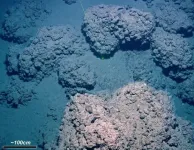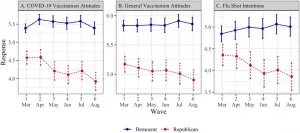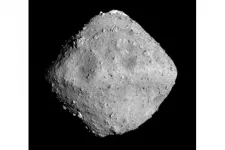INFORMATION:
Reference
Dr Panagiotis Tsiakaras is a Professor and Head at the Department of Mechanical Engineering, School of Engineering, University of Thessaly (Volos-Greece). He also is a member of the Laboratory of Materials and Devices for Clean Energy, Department of Technology of Electrochemical Processes, Ural Federal University, and Supervisor of Laboratory of Electrochemical Devices based on Solid Oxide Proton Electrolytes, Institute of High Temperature Electrochemistry (RAS), (Yekaterinburg-Russian Federation).
Research interests: Catalytic and electrocatalytic processes; Solid state electrochemistry; Electrochemical devices for energy conversion and storage; Low -, medium-and high-temperature fuel cells; Direct alcohol fuel cells for electricity generation.
P. Tsiakaras is a co-author of more than 300 scientific papers, books, and patents, with ~14000 citations and Hirsch index = 62 (based on Google Scholar database).
The new study of emerging materials helping in detection of COVID-19
International group of scientists conducted research on the electrochemical biosensors
2021-04-29
(Press-News.org) The SARS-CoV-2 virus is still causing a dramatic loss of human lives worldwide, constituting an unprecedented challenge for society, public health, and economy, to overcome. Currently, SARS-CoV-2 can be diagnosed in two different ways: i) antigen tests (point-of-care, POC) and ii) molecular tests (nucleic acid, RNA, or PCR-polymerase chain reaction). Antigen tests can detect parts of SARS-CoV-2 proteins, known as antigens, via a nasopharyngeal or nasal swab sampling method. The main advantages of POC-test include the high specificity, quick response (less than an hour), and portability, with no need of fixed laboratory facilities. On the other hand, in a molecular diagnostic test, a reverse transcriptase polymerase chain reaction (RT-PCR) is evolved, also known as nucleic acid amplification method, which requires expensive laboratory equipment, hours of analysis, and special staff.
Despite the great efforts of the scientific community towards the development of diagnostic tools and the achievement of high specificity and sensitivity of the molecular tests, the concern about the control and detection of the SARS-CoV-2 remains.
The scientist of Ural Federal University, Prof. Panagiotis Tsiakaras with his colleagues in international research groups focused on reviewing the materials used for the design and development of electrochemical biosensors for the SARS-CoV-2 detection, highlighting the significant role the electrochemistry could play in controlling COVID disease. This kind of biosensors could be a successful virus diagnostic tool of high sensitivity, specificity, low cost, quick response, requiring no special personnel and offering the advantage of the portability. The Paper was published in the Journal of Electroanalytical Chemistry.
Up to date, two main groups of materials have been thoroughly explored as transducer electrodes: i) the Au (gold)-based and ii) the carbon or graphene-based ones. Both present faster response time (within a few seconds) along with higher accuracy than the current detection methods, and most of them has also higher sensitivity. Moreover, many of them have the possibility of being portable and miniaturized.
Comparing the above two groups of materials the researchers concluded that the carbon or graphene-based ones can compete the Au-based electrodes, as they have similar or better operational characteristics, also offering the advantage of lower cost.
In the current review, scientists recognize that in the case of the Au-based electrodes, the Au was mainly used in the form of nanoparticles onto alternative support (polymer-based or other) or supported onto reduced graphene oxide before being deposited onto the basic platform. The inclusion of the r-GO (reduced graphene oxide) to the Au nanoparticles significantly ameliorates SARS-CoV-2 sensor characteristics as it expands mainly the detection area that the virus binds.
In the case of carbon or graphene-based electrodes, surface functionalization constitutes the main strategy that was followed. Especially graphene and its derivatives, which are considered the most promising materials, does not contain chemically reactive functional groups that could help immobilizing analyte biomolecules. Thus, its surface or structure alteration was investigated by: i) doping graphene with another (bio)element, or ii) creating structure defects, or iii) being used as they are to modify screen-printed carbon electrodes.
Among the applied detection techniques electrochemical impedance spectroscopy, amperometry, and differential pulse voltammetry were the most used ones. Meanwhile, in the case of the amperometric technique, there is a concern about the 'real' current response of the sensor when being in an environment with high virus concentrations, as may diffusion phenomena prevail.
Electrochemical impedance spectroscopy, square wave voltammetry, and differential pulse voltammetry detection techniques are more sensitive and reliable, especially to the very low concentration values of the target analyte. However, for acquiring the 'real' charge the optimum operational conditions are set each time (Hz or voltage step, or scan rate, etc) according to the virus concentration.
Concluding their review, Prof. Panagiotis Tsiakaras and his colleagues report that: among the explored electrode materials, Au-based and carbon or graphene-based electrodes are the two main material groups, while the nanomaterial-based electrochemical biosensors could enable a fast, accurate, and without special cost, virus detection. However, as they state, it is necessary to further research to be done in terms of various nanomaterials and novel synthesis strategies in order the SARS-CoV-2 biosensors to be commercialized.
ELSE PRESS RELEASES FROM THIS DATE:
Molecular biologists travel back in time 3 billion years
2021-04-29
A research group working at Uppsala University has succeeded in studying 'translation factors' - important components of a cell's protein synthesis machinery - that are several billion years old. By studying these ancient 'resurrected' factors, the researchers were able to establish that they had much broader specificities than their present-day, more specialised counterparts.
In order to survive and grow, all cells contain an in-house protein synthesis factory. This consists of ribosomes and associated translation factors that work together to ensure that the complex protein production process runs smoothly. While almost all components of the modern translational machinery are well known, until now scientists did not know how the ...
Poorer communities hardest hit by toxic pollution incidents
2021-04-29
Toxic pollution hits poorer populations hardest as firms experience more pollutant releases and spend less money on waste management in areas with lower average incomes.
Research from Lancaster University Management School and Texas Tech University, published in European Economic Review looked into the relationship between the location choices of potentially polluting firms and levels of local income to discover if firms made strategic decisions on site locations based on population demographics.
The team studied potentially polluting firms across Texas, and found a correlation between lower income locations and the probability of potentially polluting firms choosing to locate there. Their data, from the US Environment Agency's Toxic Release Inventory also ...
Methane release rapidly increases in the wake of the melting ice sheets
2021-04-29
Ice ages are not that easy to define. It may sound intuitive that an ice age represents a frozen planet, but the truth is often more nuanced than that.
An ice age has constant glaciations and deglaciations, with ice sheets pulsating with the rhythm of changing climate. These giants have been consistently waxing and waning, exerting, and lifting pressure from the ocean floor.
Several studies also show that the most recent deglaciation, Holocene (approximately 21ka-15ka ago) of the Barents Sea has had a huge impact on the release of methane into the water. A most recent study in Geology looks even further into the past, some 125 000 years ago, and contributes to the conclusion: Melting of the Arctic ice sheets drives the release of the potent greenhouse ...
New machine learning-based tool to help physicians determine best test for chest pain
2021-04-29
New Haven, Conn. -- The choice between two non-invasive diagnostic tests is a common dilemma in patients who present with chest pain. Yale cardiologist Rohan Khera, MD, MS, and colleagues have developed ASSIST©, a new digital decision-aiding tool.
By applying machine learning techniques to data from two large clinical trials, this new tool identifies which imaging test to pursue in patients who may have coronary artery disease or CAD, a condition caused by plaque buildup in the arterial wall.
The new tool, described in a study published April 21 in the European Heart Journal, focuses on the long-term outcome for a given patient.
"There are strengths and limitations ...
Republicans became more vaccine hesitant as the coronavirus pandemic unfolded
2021-04-29
Individuals who self-identify as Republicans became more skeptical of a potential COVID-19 vaccine and other inoculations, such as the flu shot, over the course of the pandemic, reveals a new study by the University of California San Diego’s Rady School of Management.
The paper, published in PLOS ONE, measured general attitudes toward vaccines and assessed whether study participants would get a potential COVID-19 vaccine as well as the seasonal flu shot. It also gauged trust in media.
“We found Republicans became increasingly vaccine hesitant and less trusting of media from March to August of 2020, while Democrats’ views on ...
Simple device improves care after kidney transplantation
2021-04-29
LONDON, ON - In a published study, a team from Lawson Health Research Institute has found that a simple device can reduce swelling after kidney transplantation. The geko™ device, manufactured by Sky Medical Technology Ltd and distributed in Canada by Trudell Healthcare Solutions Inc., is a muscle pump activator which significantly improves blood flow by stimulating the body's 'muscle pumps.' Patients using the device following kidney transplantation experienced shorter hospital stays and reduced surgical site infections by nearly 60 per cent.
Kidney and simultaneous pancreas-kidney transplantations ...
Meteorite amino acids derived from substrates more widely available in the early solar system
2021-04-29
Scientists have recreated the reaction by which carbon isotopes made their way into different organic compounds, challenging the notion that organic compounds, such as amino acids, were formed by isotopically enriched substrates. Their discovery suggests that the building blocks of life in meteorites were derived from widely available substrates in the early solar system.
Their findings were published online in Science Advances on April 28, 2021.
Carbonaceous meteorites contain the building blocks of life, including amino acids, sugars, and nucleobases. These ...
Mammals evolved big brains after big disasters
2021-04-29
Scientists from Stony Brook University and the Max Planck Institute of Animal Behavior have pieced together a timeline of how brain and body size evolved in mammals over the last 150 million years. The international team of 22 scientists, including biologists, evolutionary statisticians, and anthropologists, compared the brain mass of 1400 living and extinct mammals. For the 107 fossils examined--among them ancient whales and the oldest Old World monkey skull ever found--they used endocranial volume data from skulls instead of brain mass data. The brain measurements were then analyzed along with body size ...
Unlocking herbaria biodiversity using a QR code sampling-to-sequencing workflow
2021-04-29
Within the past decade, next-generation sequencing technologies have revolutionized the way in which genetic data are generated and analyzed. In the field of phylogenetics, this has meant that researchers are rapidly reconstructing the tree of life, a goal that biologists have been working toward since Darwin sketched the first phylogeny in his notebook in 1837.
Yet despite the relative ease with which DNA can now be sequenced in large quantities, scientists must first extract that DNA from an organism, often relying on vast numbers of curated specimens ...
If slightly high blood pressure doesn't respond to lifestyle change, medication can help
2021-04-29
DALLAS, April 29, 2021 -- Health care professionals should consider prescribing medication for patients with slightly elevated blood pressure if levels do not decrease after six months of healthy lifestyle changes, according to a new scientific statement from the American Heart Association. The statement, published today in the Association's journal Hypertension, fills a gap in guideline recommendations by addressing how to manage untreated, stage 1 high blood pressure - levels of 130-139/80-89 mm Hg - that was not fully addressed in the 2017 treatment guidelines.
The 2017 American College of Cardiology/American Heart Association Blood Pressure Management ...
LAST 30 PRESS RELEASES:
Tracing the quick synthesis of an industrially important catalyst
New software sheds light on cancer’s hidden genetic networks
UT Health San Antonio awarded $3 million in CPRIT grants to bolster cancer research and prevention efforts in South Texas
Third symposium spotlights global challenge of new contaminants in China’s fight against pollution
From straw to soil harmony: International team reveals how biochar supercharges carbon-smart farming
Myeloma: How AI is redrawing the map of cancer care
Manhattan E. Charurat, Ph.D., MHS invested as the Homer and Martha Gudelsky Distinguished Professor in Medicine at the University of Maryland School of Medicine
Insilico Medicine’s Pharma.AI Q4 Winter Launch Recap: Revolutionizing drug discovery with cutting-edge AI innovations, accelerating the path to pharmaceutical superintelligence
Nanoplastics have diet-dependent impacts on digestive system health
Brain neuron death occurs throughout life and increases with age, a natural human protein drug may halt neuron death in Alzheimer’s disease
SPIE and CLP announce the recipients of the 2025 Advanced Photonics Young Innovator Award
Lessons from the Caldor Fire’s Christmas Valley ‘Miracle’
Ant societies rose by trading individual protection for collective power
Research reveals how ancient viral DNA shapes early embryonic development
A molecular gatekeeper that controls protein synthesis
New ‘cloaking device’ concept to shield sensitive tech from magnetic fields
Researchers show impact of mountain building and climate change on alpine biodiversity
Study models the transition from Neanderthals to modern humans in Europe
University of Phoenix College of Doctoral Studies releases white paper on AI-driven skilling to reduce burnout and restore worker autonomy
AIs fail at the game of visual “telephone”
The levers for a sustainable food system
Potential changes in US homelessness by ending federal support for housing first programs
Vulnerability of large language models to prompt injection when providing medical advice
Researchers develop new system for high-energy-density, long-life, multi-electron transfer bromine-based flow batteries
Ending federal support for housing first programs could increase U.S. homelessness by 5% in one year, new JAMA study finds
New research uncovers molecular ‘safety switch’ shielding cancers from immune attack
Bacteria resisting viral infection can still sink carbon to ocean floor
Younger biological age may increase depression risk in older women during COVID-19
Bharat Innovates 2026 National Basecamp Showcases India’s Most Promising Deep-Tech Ventures
Here’s what determines whether your income level rises or falls
[Press-News.org] The new study of emerging materials helping in detection of COVID-19International group of scientists conducted research on the electrochemical biosensors







